The 630s decade ran from January 1, 630, to December 31, 639.

Year 634 (DCXXXIV) was a common year starting on Saturday of the Julian calendar. The denomination 634 for this year has been used since the early medieval period, when the Anno Domini calendar era became the prevalent method in Europe for naming years.
Osric was a King of Deira in northern England. He was a cousin of king Edwin of Northumbria, being the son of Edwin's uncle Æthelric of Deira. Osric was also the father of Oswine.

The Muslim conquest of Persia, also called the Muslim conquest of Iran, the Arab conquest of Persia, or the Arab conquest of Iran, was a major military campaign undertaken by the Rashidun Caliphate between 632 and 654. As part of the early Muslim conquests, which had begun under Muhammad in 622, it led to the fall of the Sasanian Empire and the eventual decline of Zoroastrianism, which had been predominant throughout Persia as the nation's official religion. The persecution of Zoroastrians by the early Muslims during and after this conflict prompted many of them to flee eastward to India, where they were granted refuge by various kings.

The Ridda Wars were a series of military campaigns launched by the first caliph Abu Bakr against rebellious Arabian tribes, some of which were led by rival prophet claimants. They began shortly after the death of the Islamic prophet Muhammad in 632 and concluded the next year, with all battles won by the Rashidun Caliphate.
The Battle of the River, also known as Battle of Al Madhar, took place in Mesopotamia between the forces of the Rashidun Caliphate and the Sasanian Empire. Muslims, under Khalid ibn al-Walid's command, defeated the numerically superior Sasanian army.

The Battle of Walaja was fought in Mesopotamia in May 633 between the Rashidun Caliphate army under Khalid ibn al-Walid and Al-Muthanna ibn Haritha against the Sassanid Empire and its Arab allies.

The Battle of Ayn al-Tamr took place in modern-day Iraq (Mesopotamia) between the early Muslim Arab forces and the Sassanians along with their Arab Christian auxiliary forces. Ayn al-Tamr is located west of Anbar and was a frontier post which had been established to aid the Sassanids.
The Battle of Daumat al-Jandal took place between Muslims and Rebel Arab tribes in August 633 CE. This was a part of the Riddah wars. Daumat al-Jandal was given to Iyad ibn Ghanm to crush the rebels, but he failed in doing so, and send for help to Khalid ibn Walid who was in Iraq in those days.

Battle of Muzayyah was between the Muslim Arab army and the Sasanian Empire. When Khalid ibn Walid left from Ayn al-Tamr to Dumat Al-Jandal for the help of Iyad ibn Ghanm, the Persian court believed that Khalid had returned to Arabia with a large part of his army. The Persians decided to throw the Muslims back into the desert and regain the territories and the prestige which the Persian Empire had lost. The Persians had resolved not to fight Khalid again, but they were quite prepared to fight the Muslims without Khalid ibn al-Walid.

Battle of Saniyy was between the Muslim Arab army and the Sasanian Empire. When Khalid ibn Walid gone from Ayn al-Tamr to Dumat Al-Jandal for the help of Iyad ibn Ghanm, The Persian court believed that Khalid had returned to Arabia with a large part of his army, Persians decided to throw the Muslims back into the desert and regain the territories and the prestige which the Empire had lost. The Persians had resolved not to fight Khalid again, but they were quite prepared to fight the Muslims without Khalid ibn al-Walid. Khalid ibn al-Walid first defeated them at the battle of Muzayyah and then advanced towards Saniyy.

The battle of Zumail was fought in 633 CE in Mesopotamia. It was a major Muslim victory in their conquest of that area. Under cover of night the Arab Muslims attacked the Christian-Arab forces, loyal to the Sasanian Empire, from three different sides. The Christian-Arab forces were unable to withstand the Muslim's surprise attack and soon dispersed but failed to escape from the battlefield and became the victims of a three sided attack by Khalid ibn al-Walid's army. At Zumail nearly the whole Christian Arab army was slaughtered by Khalid's Corps.

The Battle of Ullais was fought between the forces of the Rashidun Caliphate and the Sasanian Persian Empire in the middle of June 633 AD in Iraq, and is sometimes referred to as the Battle of Blood River since, as a result of the battle, there were enormous amounts of Persian Sasanian and Arab Christian casualties.

The Battle of the Iron Bridge was fought between the Muslim Rashidun army and the Byzantine army in 637 AD. The battle took its name from a nearby nine-arch stone bridge spanning the Orontes River which had gates trimmed with iron. It was one of the last battles fought between the Byzantines and Rashidun Caliphate in the province of Syria. The aftermath of the battle marked the nearly complete annexation of the province into the Rashidun Caliphate with the fall of its capital, Antioch.

The Rashidun Caliphate consisted of the first four successive caliphs (lit. 'successors') — Abu Bakr, Umar, Uthman, and Ali — who led the Muslim community/polity from the death of the Islamic prophet Muhammad in 632, to the establishment of the Umayyad Caliphate in 661. The Caliphate's first 25-years were characterized by rapid military expansion during which it was the most powerful economic, cultural, and military force in West Asia and Northeast Africa. By the 650s, in addition to the Arabian Peninsula, the caliphate had subjugated the Levant to the Transcaucasus in the north; North Africa from Egypt to present-day Tunisia in the west; and the Iranian Plateau to parts of Central and South Asia in the east. The caliphate ended in a five-year period of internal strife. The title Rashidun comes from the belief in Sunni Islam that the caliphs were 'rightly guided', and therefore constituted a religious model to be followed and emulated. The caliphs are also known in Muslim history as the "orthodox" or "patriarchal" caliphs.

The Battle of Sallasil, often referred to as the Battle of Chains, was the first battle fought between the Rashidun Caliphate and the Sasanian Persian Empire in April 633. The battle was fought in Kazima by the forces of Khalid ibn al-Walid and the Persians under Hormozd. It was fought soon after the Ridda Wars were over and the Arabian Peninsula was united under the authority of the Caliph Abu Bakr. Indeed, it was the first battle of the Rashidun Caliphate in which the Muslim army elected to extend its frontiers outside of Arabia, thus initiating the Arab conquests.

Khalid ibn al-Walid ibn al-Mughira al-Makhzumi was a 7th-century Arab military commander. He initially led campaigns against Muhammad on behalf of the Quraysh. He later became a Muslim and spent the remainder of his career serving Muhammad and the first two Rashidun caliphs: Abu Bakr and Umar. Khalid played leading command roles in the Ridda Wars against rebel tribes in Arabia in 632–633, the initial campaigns in Sasanian Iraq in 633–634, and the conquest of Byzantine Syria in 634–638.
Al-Qaʿqāʿ ibn ʿAmr ibn Mālik Al-Tamīmī was an Arab Muslim commander and general in the Rashidun army who belonged to the tribe of Banu Tamim. He and his tribe converted to Islam possibly during the time of Ahnaf ibn Qais. He is known as a successful military commander who took part in two important victorious battles in the early Muslim Conquest, the Battle of Yarmouk against the Byzantine Empire and the Battle of al-Qadisiyyah against the Sassanian Empire which was led by Sa`d ibn Abi Waqqas. The Caliph Abu Bakr praised him as an equal to eleven thousand men so in return the caliph's successor, caliph Umar, only sent Qaʿqāʿ and a handful of bodyguards in the first wave of reinforcements to Al-Qadissiyah. Qaʿqāʿ was one of the most illustrious military figures of his era.

The Arab conquest of Mesopotamia was carried out by the Rashidun Caliphate from 633 to 638 AD. The Arab Muslim forces of Caliph Umar first attacked Sasanian territory in 633, when Khalid ibn al-Walid invaded Mesopotamia, which was the political and economic centre of the Sasanian state. From 634 to 636 AD, following the transfer of Khalid to the Byzantine front in the Levant, the hold of Arab forces on the region weakened under the pressure of Sasanian counterattacks. A second major Arab offensive in 636 and ended in January 638 with the capture of Mosul and the consolidation of Arab control over and exclusion of Sasanid influence from the whole Mosul-Tikrit region.
The Battle of Husayd took place between Rashidun caliphate army under Al-Qa'qa' ibn Amr al-Tamimi against the warriors of Arab Christian and Sasanian army of 633 AD. Rashidun army defeated the coalition army in decisive battle and all the coalition commanders involved in this battle has fallen.












